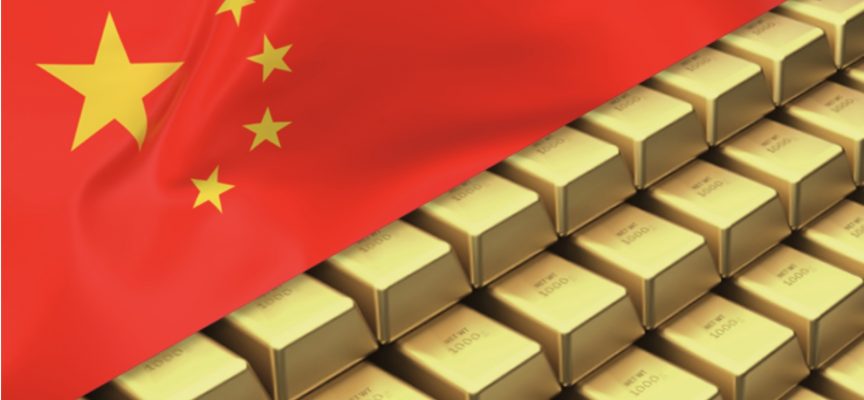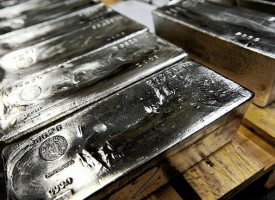With many people wondering when the paper manipulation of gold will come to an end, it looks like China is now setting the stage for gold to reenter the monetary system thousands of dollars above the current price.
June 17 (King World News) – Dr. Stephen Leeb: “The Chinese apparently, and with good reason, view Americans as a naïve people that will accept almost anything at face value. When you analyze recent news stories covering or related to U.S.-China relations, you start to see how China is playing on this in gaining the upper hand in a battle for worldwide hegemony…
Listen to the greatest Egon von Greyerz audio interview ever
by CLICKING HERE OR ON THE IMAGE BELOW.
Dr. Stephen Leeb continues: “As China gets closer to achieving its goals, I believe the battle for the East and most of the developing world is nearly over, but I still hope it will allow for a win-win situation that let’s both East and West flourish. Though win-win is looking a little more quixotic these days, I’m still hoping the U.S. can emerge as a vibrant 21st century economy.
Gold Reentering The Monetary System
Whatever the outcome, though, the real winners will be those who bet heavily on commodities and especially on gold. As I have pointed out before, gold and the yuan have become closely linked. Both the 52-week and 200-day moving averages of gold’s price in yuan have been remarkably steady for more than a year. Whether this is due to arbitrage or manipulation, it really does not matter: The message is that the yuan has become as good as gold.
This is the first step in creating a gold-based monetary system that will govern in the East – and if the West is smart, in the West as well. As China clears away the obstacles to ever more Eastern trading in yuan, gold will rise longer and higher than most people imagine. The current transition is arguably the most significant in the history of modern civilizations.

But as I said, China has managed to keep its progress well disguised. Let’s begin with the recent Korea summit between President Trump and Premier Kim. The clear takeaway is that the U.S. will be willing to limit its military involvement on the Korean peninsula in exchange for North Korean denuclearization. Unlike the many skeptics, I believe this actually will happen, along with a much more vibrant North Korean economy and eventual North-South reunification. Moreover, I believe the denuclearization will happen fairly quickly, and that by the turn of the decade there will be little doubt about the outcome.
By 2020, China will be helping to turn North Korea’s nearly moribund economy into one that is vibrant and trading with many other Eastern partners. The entire Korean peninsula will be well on its way to joining the Eastern economic bloc of countries. If you’ve followed my King World News interviews with for a while, this prediction shouldn’t be a surprise. Nearly one year ago on KWN I talked about Korea in the wake of Steve Bannon’s exit from the White House. That exit had been precipitated in part by comments Bannon had made that contradicted Trump’s bluster. Specifically, Bannon said it was nonsense to believe the U.S. had a military option, because any military action would lead to the deaths of 10 million people in Seoul in the first 30 minutes through conventional weapons alone.
I noted then:
“Bannon raised the idea of a deal in which China would get North Korea to freeze its nuclear build-up and agree to verifiable inspections in exchange for the U.S. removing all its troops from South Korea. But he called the likelihood of that happening remote.”
My comment at the time was:
“I don’t think such a deal is farfetched…there are few alternatives…The big picture is that China continues to make unrelenting progress in uniting the East and the developing world under its umbrella, while overcoming whatever remaining obstacles the West could pose.”
A week before that, talking about the North Korea nuclear threat, I said:
“The current crisis could easily mark America’s last gasp at keeping a foothold in Asia as well as in the rest of the East. These geopolitical implications should be seen as potentially momentous and as enormously positive for gold.”
That was a year ago, and everything I said then seems borne out by the most recent events. Stay tuned.
Now some thoughts on ZTE and the state of Chinese technology in general. In mid-April, the U.S. government charged Chinese phone maker ZTE with violating a previous sanctions settlement and banned ZTE from buying U.S. technology for seven years. ZTE indicated that once its inventory of critical products was used up, the company would have to cease operations, and 75,000 employees would lose jobs. You could almost hear the sighs of relief among Americans who had feared China had caught up, or nearly so, to the U.S. in developing critical technologies. The putative plight of ZTE seemed to say there was no need to worry, and that for the foreseeable future the U.S. would continue to call the shots in the tech arena.
In line with this, on June 10 The New York Times introduced a new weekly feature by Li Yuan whose mission was to examine “the paradox of modern China through the lens of technology.” The inaugural article focused on ZTE. Examining whether China really has “defied the axiom that a free political system and economic growth go hand in hand”, Li wrote that: “As the Chinese ask how they can keep up, many are also wondering why they didn’t realize they were so far behind to begin with.”
There’s a problem with this analysis, however, which is that loss of access to U.S. suppliers did not necessitate the failure of ZTE. The optical chips and the more important SoC chips, the critical components of a phone’s modem and operating system, are available elsewhere, from South Korea and Taiwan, for example. In fact, another potential supplier is Huawei, a private Chinese company that is the leading developer and manufacturer of smartphones in China and perhaps the world.

Unlike ZTE, Huawei is a vertically integrated company, which means it makes both hardware and software for its phones. Though the company imports about 25 percent of its phones’ components from the U.S., these are commoditized products available from a number of other suppliers outside the U.S. and in many cases in China itself. Huawei, similar to Apple, has firm control of both the software and hardware it requires. Both companies use Taiwan Semiconductor to manufacture their internally designed SoC’s.
The latest versions of each SoC are Apple’s A11 and Huawei’s Kirin 980. When compared on the most popular benchmark, AnTuTu, the Kirin is ahead by about 50 percent and indeed blows out all other SoC’s as well. One website, Archyworldys, called the Kirin’s benchmark reading, “a real leap into the unknown.” Yet Li’s article failed to mention Huawei.
I see two possible explanations for the whole ZTE situation. One is that China wants to keep the U.S. at bay by appearing to be less technologically advanced than it really is. The New York Times is an inadvertent partner in this strategy. I’m sure I sound like a broken record, but once again I must cite The Art of War’s oft-cited maxim that it’s smart to show your weakness, hide your strength.
The other possibility is that China’s government decided to make an example of ZTE to warn other Chinese companies that if they become too dependent on the U.S., they won’t get a chance to find new suppliers. It’s possible, maybe even likely, that the government told ZTE that it had made a mistake and must pay for it.
A final comment: one other thing Apple and Huawei have in common is that they both use the same China-based company, Foxconn, to assemble their phones. That should tell you a lot about which country, the U.S. or China, could lever the greatest blow against the other.

The Gold Road
I want to briefly return to how China is paving the road – perhaps more precisely the Belt and Road – for broad-based yuan/gold backed trading. China is off and running in trading its yuan-based oil benchmark. That the yuan can be exchanged for gold may be one reason for the tight relationship between the yuan and gold. It may be a natural consequence of arbitrage (plus, perhaps a little meddling from the Chinese).
And the “good as gold” yuan is spreading its wings. Just this week the lead article in “liveMint”, a well-respected financial daily out of India, had the following subhead: “China has chosen the right time to step up its efforts to make the yuan a global currency.” The article points to a recent forum in Harare, Zimbabwe in which 14 East African and Southern African countries met to consider using the yuan as a reserve currency in the region.
These countries all owe large debts to China, clearly giving China the leverage to make it happen. The article states:
“After becoming the preferred trade partner for the African continent, China’s ambitions have expanded to operate the preferred reserve currency for nations in the region. This strategy could have significant consequences at a time when Africa is being touted as the ‘next factory of the world’ after China…one may take manufacturing out of China, but one cannot take China out of manufacturing.”
Equally significant was news out of Dubai in late April. The Reuters headline was “Abu Dhabi, Shanghai plan exchange focusing on China trade.” Richard Teng, head of the Abu Dhabi Global Market (ADGM), noted “the new exchange will support not only the Belt and Road initiative but also the internationalization of the Chinese yuan in the region.”
China’s ultimate goal, as I’ve discussed before, isn’t to replace the dollar with the yuan. Rather, it’s to create some sort of basket of currencies and commodities linked to gold. The size of the Chinese economy and its vast gold holdings will give it enough sway over any such basket while sparing it the headaches associated with having a reserve currency.
For investors, the bottom line is that whether the new reserve currency is the yuan itself or a basket, transactions will be gold-backed, implying a gold price many times the current level and many times the past high. The message is to ignore the day to day turbulence and continue to insure your future by aggressive accumulation of gold.”
To listen to the timely KWN audio interview with James Turk that discusses the smash in the gold and silver markets CLICK HERE OR ON THE IMAGE BELOW.
***ALSO JUST RELEASED: ALERT: Criminal Bullion Banks Shorted The Hell Out Of Silver Ahead Of Yesterday’s Takedown CLICK HERE.
© 2018 by King World News®. All Rights Reserved. This material may not be published, broadcast, rewritten, or redistributed. However, linking directly to the articles is permitted and encouraged.









